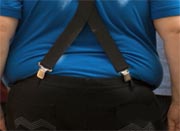
FRIDAY, Sept. 14 (HealthDay News) — Rural areas of the United States are affected by the obesity epidemic even more than urban centers, a new study finds.
Researchers at the University of Florida said that nearly 40 percent of rural adults were obese (having a body mass index of 30 or higher) compared to 33 percent of people living in urban areas.
Living in the country did not mean people got more exercise, the study found. Instead, people living in cities and those living in rural areas got about same amount of physical activity. The researchers noted however, that rural residents consumed a much higher percentage of their daily calories from fat.
The findings add to those from prior studies that have shown that heavy meals and limited access to healthy foods are common in rural areas, the researchers said.
Still, “I was surprised by the magnitude of the rural-urban difference — it was larger than expected and much larger than previously estimated,” study senior author Michael Perri, a professor and dean of the UF College of Public Health and Health Professions, said in a university news release.
In conducting the study, his team examined data on more than 7,300 people living in cities and 1,490 rural residents, using information from the 2005-2008 National Health and Nutrition Examination Survey, conducted by the National Center for Health Statistics.
All of the participants were between 20 and 75 years old. The study revealed that a diet with a higher percentage of calories from fat was the biggest predictor of obesity and a major reason why obesity rates are higher in rural America than in U.S. cities.
The researchers said that people in rural areas were also more likely to be obese if they were married or black. Meanwhile, city residents were more likely to be obese if they were older, black, had less education, were sedentary and consumed a higher percentage of calories from fat.
The higher rate of obesity in rural areas was even evident among younger study participants, ranging in age from 20 to 39 years old. The researchers suggested this may be partly due to technology that has mechanized many traditional rural jobs, such as farming and logging.
“This analysis can be a turning point in the efforts to ensure adequate attention to obesity in rural America,” added Shiriki Kumanyika, a professor of epidemiology at the University of Pennsylvania Perelman School of Medicine, who was not involved in the study. “The findings about demographic and behavioral factors that relate to obesity remind us that approaches for addressing obesity differ somewhat in rural and urban areas.”
Efforts to fight obesity in the United States should specifically target rural areas, where residents face more barriers to health care and are more likely to be affected by chronic disease and premature death, the researchers said.
The study was published in the fall issue of the Journal of Rural Health.
More information
The U.S. National Institutes of Health provides more information on obesity.

